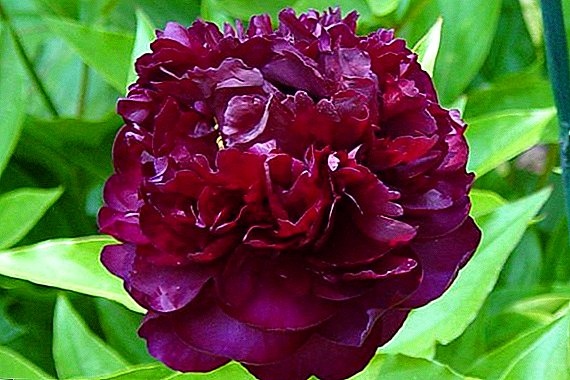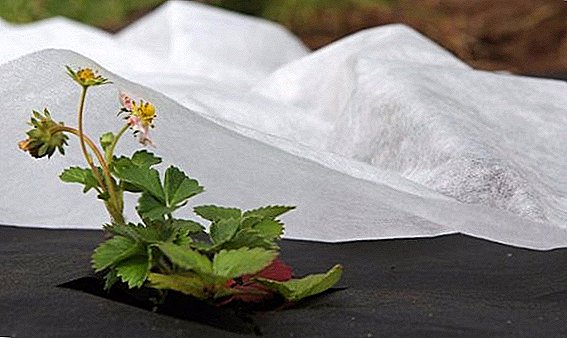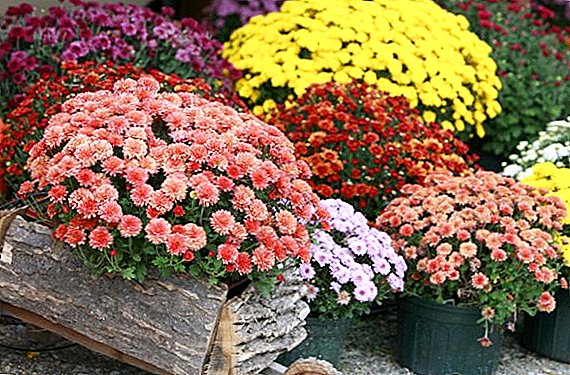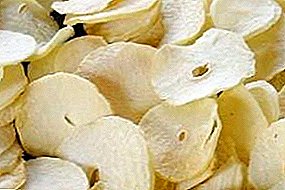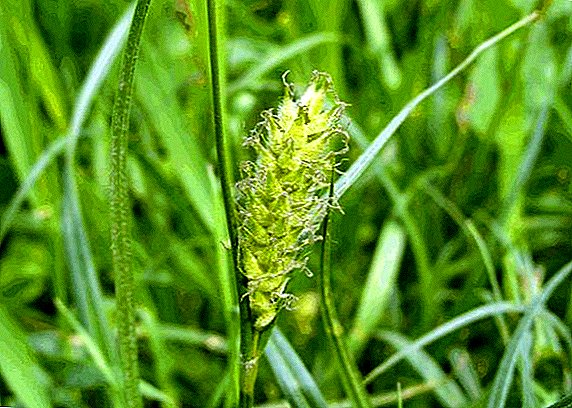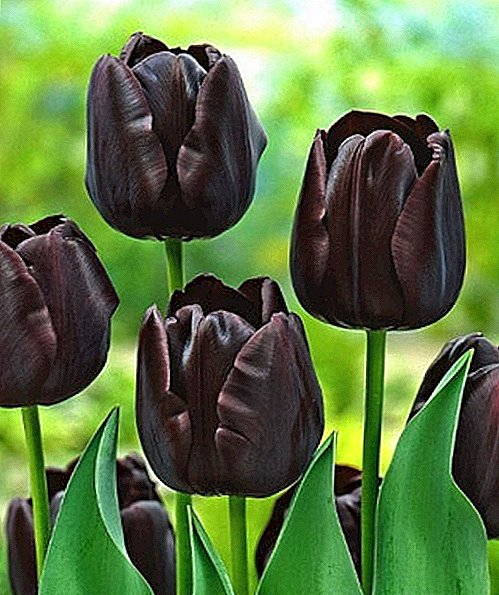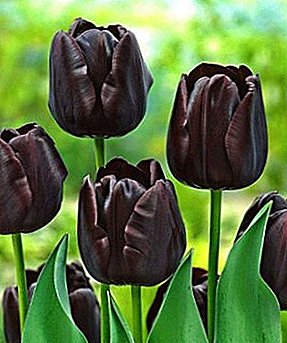 Tulips are beautiful spring flowers and delight the gardeners in April and May. They are also often used for earlier forcing. Now there is a big variety among color scale, the sizes and forms of this popular flower. Among them, a worthy place is occupied by a group of black flowers.
Tulips are beautiful spring flowers and delight the gardeners in April and May. They are also often used for earlier forcing. Now there is a big variety among color scale, the sizes and forms of this popular flower. Among them, a worthy place is occupied by a group of black flowers.
Black tulips
Black tulips called varieties that have a dark, close to black color, color, which can be dark purple, maroon or dark blue tones. The appearance of black tulips is associated with tulipmania in Holland (1636-1637), which raised interest in rare varieties of this flower to unprecedented heights.
Since the middle of the XVII century, it became known about tulips from the northern Dutch city of Haarlem, which had a rich purple color.  However, the true black color was achieved by the Danish breeder Henku Hageman only in 1986 at the Institute of Floristics in the Netherlands. This flower is actually such a dark purple color that seems almost black in any light and on any background.
However, the true black color was achieved by the Danish breeder Henku Hageman only in 1986 at the Institute of Floristics in the Netherlands. This flower is actually such a dark purple color that seems almost black in any light and on any background.
Did you know? Due to its unusual color, black tulip was mentioned in the famous novel by A. Dumas "Black Tulip". In the story of this novel, the local authorities of the city of Haarlem announced a reward to the author of this unusual flower. This species in the book by Dumas was derived by Dr. Berle and named it after his wife "Rose Berle".
Description and names of the most popular
The group of black tulips includes different varieties. Of course, none of them are completely black. Everything else, on the thickness of the dark color affects lighting.
Black jack
This variety has a dark purple color, belongs to the most numerous group "Triumph". He has a classic goblet bud, which never opens up. 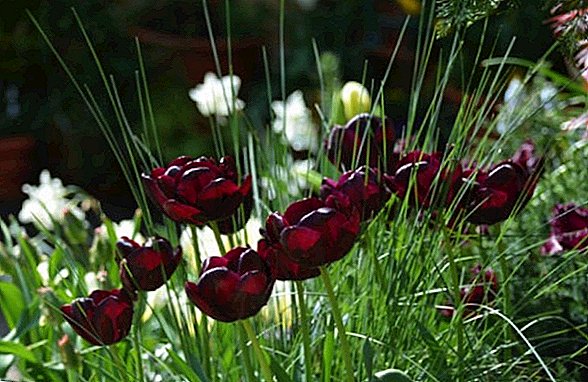 It grows up to 40-60 cm and has a strong stalk, which makes it convenient to cut. Blossoms in April-May, suitable for forcing in the greenhouse.
It grows up to 40-60 cm and has a strong stalk, which makes it convenient to cut. Blossoms in April-May, suitable for forcing in the greenhouse.
Ronaldo
The maroon variety also belongs to the group "Triumph" and has similar indicators. Tulips of this group are considered to be quite unpretentious and can grow in windy places thanks to a sturdy stem and bud. Mid-flowering (April-May), suitable for flowerbeds and forcing. 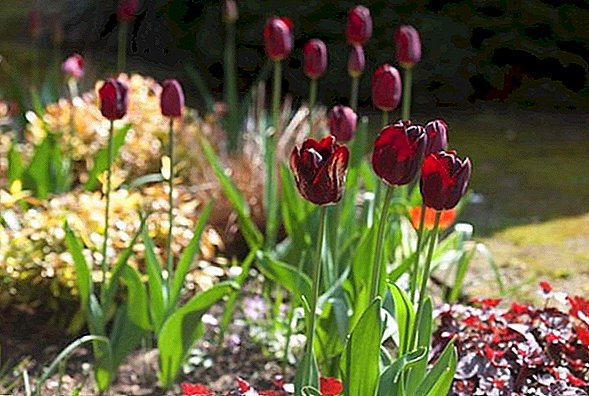 Gardeners celebrate its noble velvet dark color and large flowers that can reach 8 cm.
Gardeners celebrate its noble velvet dark color and large flowers that can reach 8 cm.
Queen of Night
Black and maroon "Queen of the Night" is considered one of the most black flowers. It belongs to the simple late flowering varieties and blooms about three weeks in mid-May. It has a goblet, large (about 9 cm tall) flower and a strong, tall stem.
Did you know? Black tulips are not the only flowers with this color. Among the popular flowers grown by gardeners, there are almost black pansies., irisesmaroon mallow, almost black mahogany-grape lily. The black velvet petunia variety possesses almost completely black color, and it is not the only petunia with such color, but the darkest among its kind. Among the roses, only one variety with black and maroon petals is bred.whose color density depends on the growing conditions.
It can grow in a sunny place, and in partial shade. This tulip grows to 65 cm. It is suitable for garden decoration, forcing middle and late dates, good for cutting for bouquets. 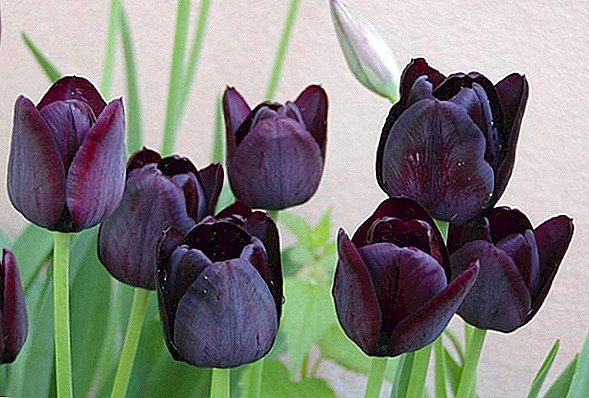
Black and white
Tulips in this class belong to the variegated Rembrandt tulips. They have a surprisingly contrasting, black and white, streaky color. Initially, these flowers were affected by the variegated virus, so they should be planted separately from other varieties in the garden to avoid infection.
Such varieties are grown with care. In the Netherlands, even a ban has been imposed on the cultivation of variegated species, but for some spectacular old varieties they have nevertheless made an exception. 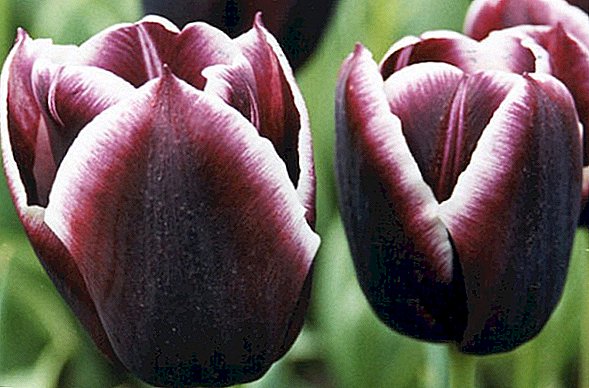 This is a medium-sized tulip (40-70 cm) with a goblet flower, whose petals can fully open in the sun. It blooms from mid-May and is suitable for cutting.
This is a medium-sized tulip (40-70 cm) with a goblet flower, whose petals can fully open in the sun. It blooms from mid-May and is suitable for cutting.
Black hero
Another tulip maroon, almost black tones. It belongs to late terry varieties, which are also called pion-like for their flower, having 15-20 petals each. The bud is usually up to 7 cm tall, and in full disclosure the flower can reach 11 cm in diameter.
The tulip itself grows to 50-55 cm and has an average growth rate. Flowering occurs in late May. It can be planted in the garden, both in the sun and in the shade. It is suitable for cutting and looks great in bouquets. This variety can be used for forcing in greenhouses. 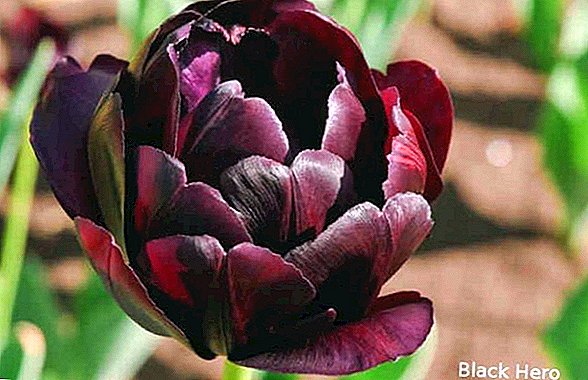
Black parrot
This maroon flower belongs to parrot tulips, different wavy petals, which are visible green stripes. The head of flowers of this variety reaches a height of 10 cm, and in width, with full disclosure of corrugated petals, sometimes up to 20 cm.
Strong stem reaches 45 cm. It grows well in full sun and in partial shade. Blossoms at the end of May 2-3 weeks, a plant of average growth rate Good for cutting and for garden decoration. 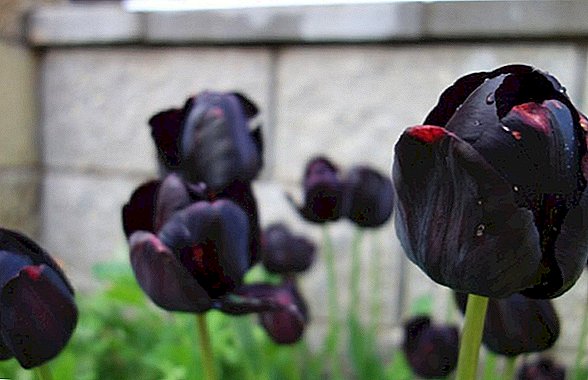
Cuban night
Black tulip of this variety belongs to the fringed species, in which the petals on the edge have an interesting needle edging. Color can vary from black and maroon to black and purple. It blooms in May and reaches a height of about 55 cm.
It has a strong stem and is good at cutting, looks great in bouquets. It can be grown in flowerbeds or used for forcing. 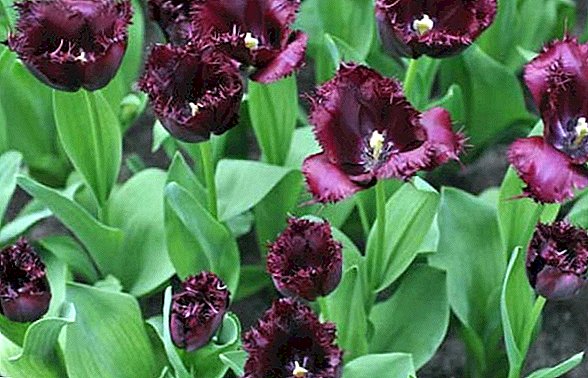
Black beauty
This tulip has an almost black color with a slight burgundy tone. It belongs to simple late types and blossoms from the middle of May, its stalk reaches 65 cm.
It has a large goblet flower and is good for cutting, great for decorating the garden. 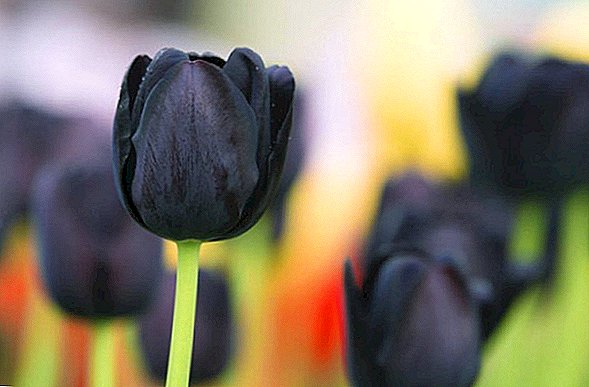
The best conditions for black tulips
Before you plant these elegant flowers in your garden, you should choose and prepare a place for planting the bulbs.
Soil requirements
Tulips love fertile, well-drained soils with neutral or slightly acidic acidity.
Sour land for them should be chilled. They like sandy land. It is undesirable for the predecessors to be potatoes, tomatoes or eggplants, since these flowers have common diseases with the nightshade.
Find out what is important soil acidity for plants, how to determine the acidity of the soil at the site, how to deoxidize the soil, as well as how to improve soil fertility.
They love complex fertilizers containing superphosphates, potassium salt and nitrogenous compounds. But usually gardeners make humus or compost.
The choice of lighting
Most of these flowers may well grow in partial shade, but prefer lighted areas. If black tulips are planted in the shade, they will grow there, but weakly, and will not look very good.
It is best to choose a place for them with good illumination, especially varietal tulips, which include black, prefer sunny places. 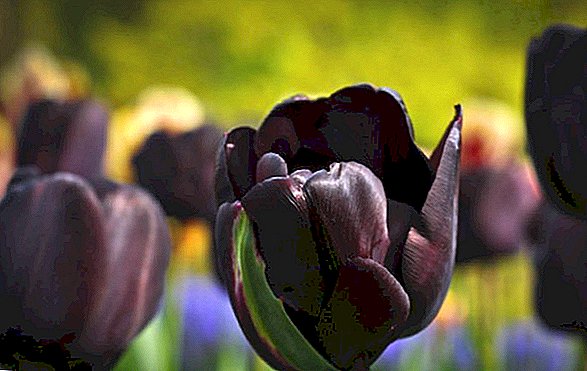
Optimum humidity
The bulbs of these plants do not tolerate waterlogging and stagnant water. Lowlands, in which puddles form in spring, are destructive for them. At the same time, during the period of activity, they need stable, light soil moisture, and during the dry season they will need watering.
Features and basic rules of landing
These bulbous plants are usually planted in autumn in September-October. Planting is also acceptable in the spring, but then in the first year you are unlikely to wait for flowering. First of all, when planting, they are guided by the temperature of the soil - it should be + 5-7 ºС.
It should also be borne in mind that the bulbs need 3-4 weeks for rooting before frost. If they do not have time to take root, they may die or take root in the spring, but the flower from such a bulb will be weak. Early planted bulbs can sprout, which will not tolerate the first frost.
The soil begins to prepare for 2-4 weeks before planting the bulbs. They dig it together with fertilizer (humus, compost or complex fertilizers). The prepared place is covered with a film to prevent the appearance of weeds, and from September the planting of planting material begins.
Before disembarking, it is picked up and processed with fungicides. Sick specimens are thrown away. Most often, the bulbs are pickled in a weak (0.5%) solution of potassium permanganate.
Video: how to plant tulips The depth of embedding the bulbs into the ground depends on their size and the quality of the ground. On light soils, they are sunk into the bottom three sizes of their diameter, on heavy soils they are planted closer to the surface - two bulb sizes.
Large bulbs are preferably planted in rows with a distance between planting material of 10 cm and 20 cm between the rows themselves.
Smaller bulbs can be planted in a checkerboard pattern. If they are not planned to be dug frequently, then the distance between them should be increased to 20 cm, and with annual digging they can be planted more densely. On 1 square. m usually accounts for about 50 pieces of large bulbs of black tulips.
When planting they can not be pressed into the ground, the ground after instillation is not recommended to ram. It is also not necessary to make holes in which water can stagnate; it is better to level the soil after planting.
It will be useful for you to learn when it is better to plant tulips.
Before the frosts place with planted bulbs need to mulch.
Flower care
Caring for black tulips begins as soon as the first shoots appear. Not sprouted bulbs are removed from the ground, so as not to expose other flowers to diseases. 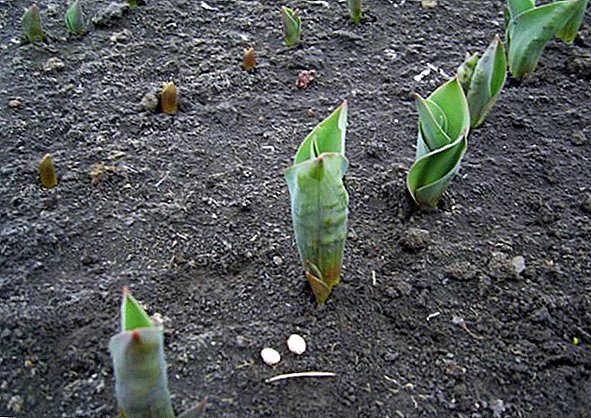
How to water
An important condition for the care of black tulips is sufficient watering. After all, the root system of these flowers is such that they are not able to get moisture from the deep layers of the earth. They are very fond of humidity, so during the period of budding, flowering, and another two weeks after its completion, they should be watered liberally and often.
Important! Be sure that there is no stagnation of water - this can lead to the process of rotting of the bulbs and the death of the plant.
On average, during irrigation they spend from 15 to 40 liters of water per 1 square meter. m. When watering, it is desirable to exclude the ingress of water on the leaves, to avoid burns.
To retain moisture, it is recommended to regularly weed and loosen the soil after each rain or watering. It also allows you to fight well with weeds that will hinder the development of black tulips. Not excessive will be the procedure for mulching the soil.
Cropping flowers
Cutting of flowers is carried out, being guided by the following rules:
- if the cultivation of tulips was carried out for further reproduction, the heads of flowers are cut for 4-8 days after blooming. This will allow the bulb to build up mass;
- all loose leaves must be removed immediately, otherwise they may accumulate in the leaf axils and begin to rot;
- cut the stems of tulips after flowering is impossible, because the bulbs will stop developing;
- if the flowers are grown for cutting, then after removing the bud with the stem, this plant is not suitable for further reproduction, since the bulb stops growing.
The approximate term for pruning and digging bulbs - from two to four weeks after completion of flowering.
Top dressing and fertilizer
Fertilize black tulips are recommended with the help of solutions. If dry dressing is chosen for this purpose, it is necessary to ensure that when applying such a fertilizer the leaves of the plant are not wet, otherwise burns may form on them. 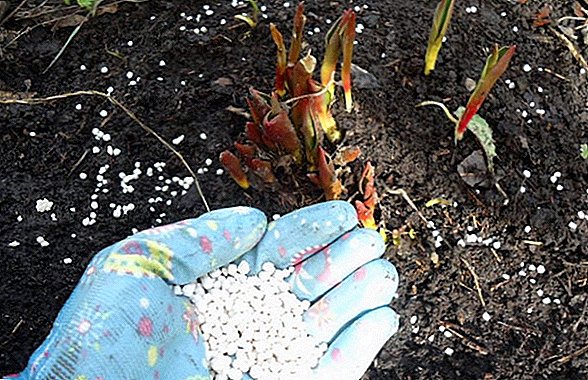 After feeding, you need to produce abundant watering so that the fertilizer along with the water is absorbed by the root system.
After feeding, you need to produce abundant watering so that the fertilizer along with the water is absorbed by the root system.
The first feeding of these flowers occurs in early spring when the first shoots appear. To carry out this procedure, dry fertilizers are scattered in the form of nitrogen, phosphorus and potassium in the proportion of 2: 2: 1 throughout the site, taking into account the norm of 50 g per 1 sq. Km. m. Then carry out watering.
The second time fertilizer is applied before the formation of buds. For this feeding, it is advisable to use an aqueous solution that will contain nitrogen, phosphorus and potassium in a ratio of 1: 2: 2, that is, the dose of nitrogen becomes less, and potassium - more.
Important! Categorically it is impossible to bring fresh or insufficiently rotted manure before planting tulips - the plants will fall ill.
Fertilizer consumption rate is 30-35 g per 1 sq. M. The last third dressing is done after the flowers have bloomed, using a solution of potassium and phosphorus in a 1: 1 ratio at the rate of 30-35 g per 1 square meter. m. In order to achieve a better development of the daughter bulbs, an additive in the form of boron and zinc can be added to the solution with fertilizers.
Pest and disease control
This type of tulip can be subject to such a dangerous disease as the variegation virus.. This disease is expressed in the presence of spots, strokes, stripes that appear on the petals and leaves of tulips.
Unfortunately, the ways to combat this virus have not been developed, but it is necessary to take the following preventive measures to avoid such trouble:
- purchase onion for planting from reputable manufacturers;
- when cutting tulips, treat the instrument with a disinfectant after each flower, because it is with the sap of the plant that such a virus gets into a healthy specimen from the patient;
- If a tulip with signs of this disease is noticed, then it should be dug together with the ground and burned. The remaining pit is well filled with a solution of potassium permanganate.
In August, these beautiful flowers may be exposed to tobacco necrosis virus.. This disease is classified as fungal. With this disease, the tulip has a curvature of the stem, there are ugly stripes on the flower, darkish spots on the bulb.
A flower that is affected by such a fungus is dug out along with the ground; the fossa is poured with a solution of manganese with the addition of boric acid. 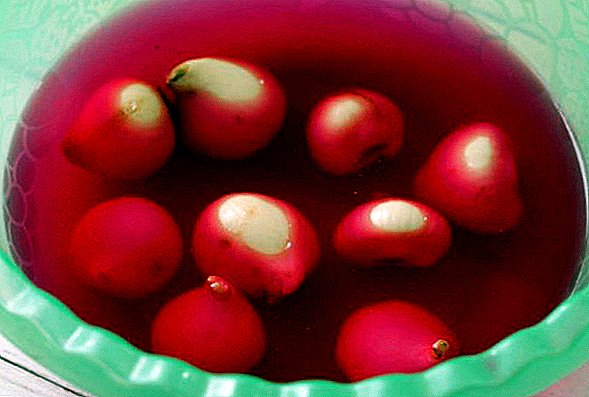 The solution is prepared in this proportion - 2 g of boric acid is taken for 10 g of manganese, and then this mixture is dissolved in one liter of water. The hole after such a watering is better covered with ashes. In order to avoid further spread of this fungus, spraying is carried out with a two percent solution of "Fundazol".
The solution is prepared in this proportion - 2 g of boric acid is taken for 10 g of manganese, and then this mixture is dissolved in one liter of water. The hole after such a watering is better covered with ashes. In order to avoid further spread of this fungus, spraying is carried out with a two percent solution of "Fundazol".
Black tulips can be affected by gray, white, brown, wet, soft or botrythia blight. They are especially susceptible to these diseases in the rainy period in spring, when there is a lot of moisture. To avoid such diseases, it is necessary to ensure good soil drainage.
As preventive measures against many diseases and pests during the period when onions are dug out at the site and before they are planted, plants are planted that are capable of releasing phytoncids.
These are calendula, marigold, mustard, etc. To avoid fungal diseases of plants, it is recommended to use fungicides. For this purpose, the site is irrigated with an aqueous solution of any type of fungicide. To prepare such a solution, take 20 g of the fungicide and dilute it in 10 l of water.
In nature, natural pests of tulips, like many other flowers, are Bears. To combat them, glass jars are instilled in the area, into which about two thirds of the water is poured. Once in such a trap, the bear can not get out. Another insect pest is lilac scoop. 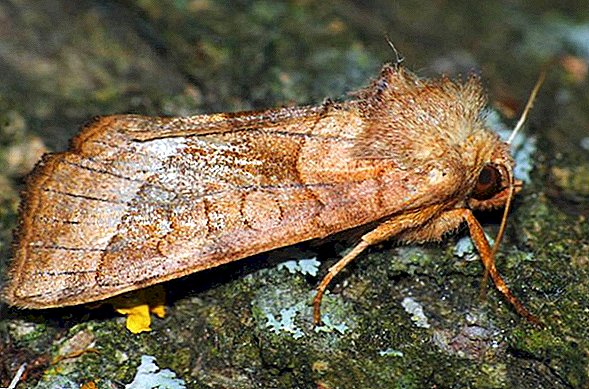 Lilac scoop To combat it, the lower part of the leaves sprinkled with naphthalene powder.
Lilac scoop To combat it, the lower part of the leaves sprinkled with naphthalene powder.
Did you know? The name of tulips came to us from Turkish. Their heads were similar to turbans, so the flower began to bear that name. For a long time, the tulip was a symbol of the Ottoman rulers.
Brown onion mite can also bring tulips a lot of trouble. To get rid of this pest, the bulbs are lowered for five minutes into the water heated to +40 ºС. If this tick is found during the growing season, then it is necessary to spray using a two percent solution of "Keltana" or "Rogora".
But when this procedure does not help, they dig out and burn the tulips. After that, tomatoes or radishes are planted in this area, as these vegetables are not afraid of these pests. 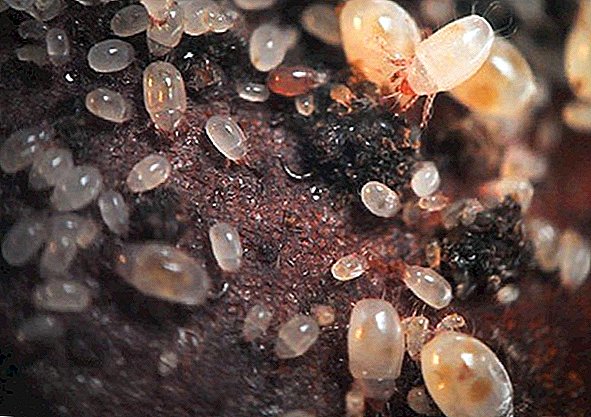 Brown onion tick Pest insects such as honey-bears, snails, slugs, are disposed of with the help of special traps that are placed throughout the site. It can be rags, pieces of plywood, slate.
Brown onion tick Pest insects such as honey-bears, snails, slugs, are disposed of with the help of special traps that are placed throughout the site. It can be rags, pieces of plywood, slate.
These insects hide under such shelters and are easier to find for further destruction.
From small rodents (for example, mice) use mousetraps. Additionally, the bulbs are treated with red iron powder before planting; this deters various pests.
Proper storage of the bulbs after flowering
Dig out onions after the tulips have faded, and most of the leaves turned yellow.
Read more about how to care for tulips after they have bloomed and how to store the bulbs before planting.
To find out whether you can dig out onions, you must first dig one of them. Well-formed roots and stains on the scales will show that the bulbs can be dug for further storage.
Carefully dig the tulip bulbs so as not to damage them. Choose for this should be a sunny day so that you can dry the bulbs in the sun.
The collected bulbs are sorted and prepared for storage.
To ensure proper storage, it is advisable to adhere to the following rules:
- bulbs cleaned from pieces of earth;
- do marking - a grade, time of collection;
- placed in a wooden box or suspended in a bag;
- move for storage in a dry, dark, without drafts room with a temperature of about +25 ° C;
- температурный режим позже снижают, он должен быть установлен не более +17 °С.
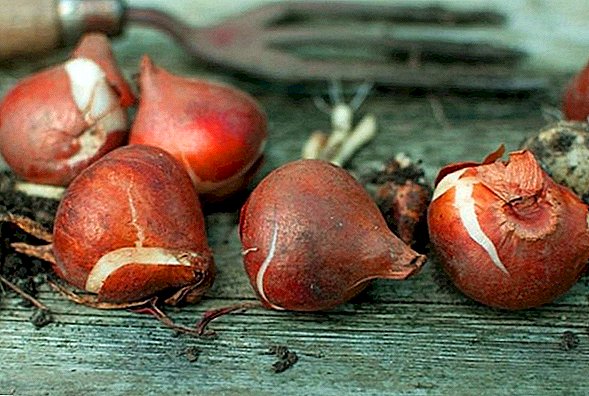
Правильное сочетание черных тюльпанов на клумбе
Black tulips in the flowerbed are perfectly combined with other spring flowers - narcissus. The black color goes very well with white and creates a beautiful contrast. These black flowers also look good with white, cream, yellow or pale pink tulips.
Such spring bulbous flowers as hyacinths, Pushkinia, Muscari are suitable for creating flower beds. Large blue hyacinths perfectly complement the composition of such unusual tulips. To create beautiful flower beds, blue forget-me-nots, low white daisies, low blue or white bells are suitable. 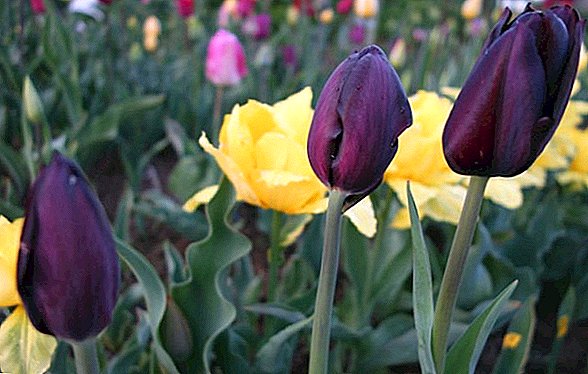 When creating long flower beds, black tulips are best planted in the foreground. Such flowers will look beautiful in open areas and near trees.
When creating long flower beds, black tulips are best planted in the foreground. Such flowers will look beautiful in open areas and near trees.
These beautiful flowers will make a beautiful composition together with perennials - hosts, ferns.
We advise you to get acquainted with the peculiarities of growing and popular varieties of white tulips.
Black tulips are unusual flowers that will look beautiful and noble on any flowerbed. They will bring rigor and majesty to your garden. If you properly care for them, they will surely delight you with their unusual flowering.


